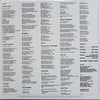







Men at Work - Business as Usual (Ultra Analog, Half-speed Mastering)
ORDER LIMITED TO ONE ITEM PER CUSTOMER
Colin Hay – guitar, lead vocals (A1–4, B1-5)
Greg Ham – flute, keyboards, saxophone, background vocals (A1–4, B1-5), lead vocals (A5)
Ron Strykert – guitar, background vocals,
John Rees – bass, background vocals
Jerry Speiser – drums, background vocals
1 LP, gatefold
Limited edition
Original analog Master tape : YES
Half-speed Mastering
GAIN 2 Ultra Analog System™
Heavy Press : 180g
Record color : black
Speed : 33RPM
Size : 12”
Stereo
Studio
Record Press : RTI
Label : MOFI
Original Label : CBS
Recorded March–September 1981 at Richmond Recorders, Melbourne
Engineered & mixed by Paul Ray
Produced by Peter McIan
Remastered by Krieg Wunderlich
Originally released in 1981
Reissued in 2016
Tracks:
Side A :
1 Who Can It Be Now?
2 I Can See It In Your Eyes
3 Down Under
4 Underground
5 Helpless Automation
Side B :
1 People Just Love to Play With Words
2 Be Good Johnny
3 Touching the Untouchables
4 Catch a Star
5 Down By the Sea
Reviews :
"Business as Usual became a surprise international hit on the basis of "Who Can It Be Now?" and "Down Under," two excellent singles that merged straight-ahead pop/rock hooks with a quirky new wave production and an offbeat sense of humor. Colin Hay's keening vocals uncannily recall Sting, and the band's rhythmic pulse and phased guitars also bring to mind a bar band version of the Police. And that helps make the remainder of Business as Usual enjoyable. There's a fair amount of filler on the record, but "Be Good Johnny," "I Can See It in Your Eyes," and "Down by the Sea" are all fine new wave pop songs, making Business as Usual one of the more enjoyable mainstream-oriented efforts of the era." AllMusic Review by Stephen Thomas Erlewine
Ultra Analog™ : The GAIN 2 Ultra Analog™ Series stems from the use of the Gain 2 system, mastered at half speed from the original master tapes where possible, capturing and uncovering as before undiscovered sonic information.
Half-speed mastering. In half-speed mastering, the whole process is slowed down to half of the original speed. A typical 33 1/3 rpm record is cut at 16 2/3 rpm. The source material is also slowed down (reducing the pitch in the process) meaning the final record will still sound normal when played back. Slowing the whole process down allows more time, which means the end result sounds better and is more efficient — allowing engineering to minimize the effects of inherent limitations within the vinyl format. The result is a more accurate and more open high-frequency response in the half speed vinyl when compared with a normal speed recording.
Ratings :
AllMusic : 4,5 / 5 , Discogs : 3,93 / 5


